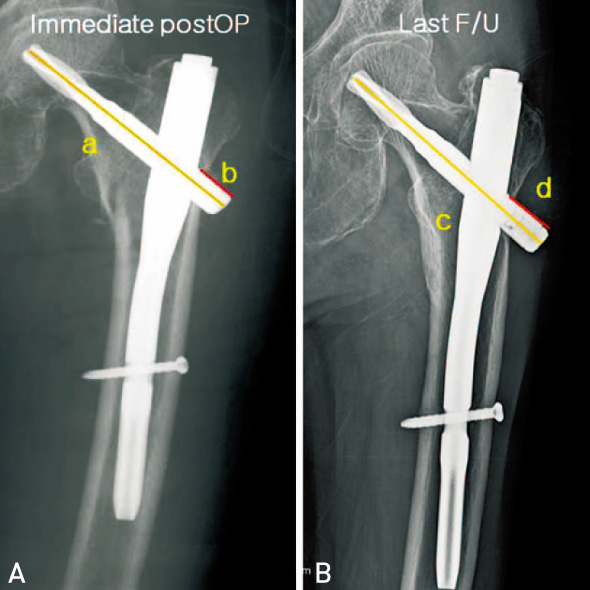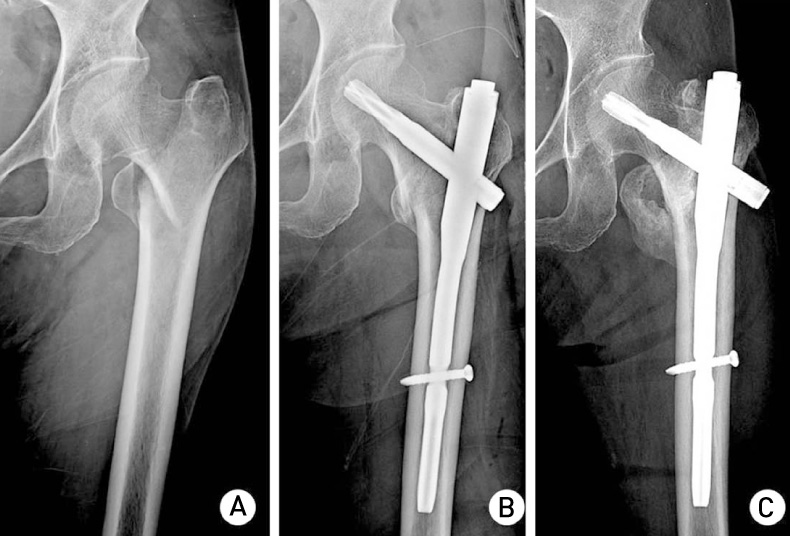Hip Pelvis.
2012 Jun;24(2):124-132. 10.5371/hp.2012.24.2.124.
Mid-term Results of Patients with Femoral Intertrochanteric Fractures Treated with Proximal Femoral Nail Antirotation
- Affiliations
-
- 1Department of Orthopedic Surgery, Ilsan Paik Hospital, College of Medicine, Inje University, Goyang, Korea. osd11@paik.ac.kr
- KMID: 1439101
- DOI: http://doi.org/10.5371/hp.2012.24.2.124
Abstract
- PURPOSE
To evaluate the mid-term results of patients with femoral intertrochanteric fractures treated with proximal femoral nail antirotation (PFNA) in the elderly.
MATERIALS AND METHODS
Between March 2008 and February 2010, 93 patients with intertrochanteric femoral fractures were treated with PFNA. Of these patients, 43 could be followed for a mean of 19.1 months (range, 12-33 months). The mean age was 77.3 years (range, 62-93 years) and there were 6 males and 37 females. According to the AO/OTA classification, there were 14 cases of A1, 25 cases of A2, and 4 cases of A3. Radiological outcomes were assessed at the union period along with the sliding distance of the antihelical blade according to fracture type. Functional outcomes were assessed according to the Chanley hip pain scoring system, walking ability, and the Activities of Daily Living (ADL) index.
RESULTS
All patients, except for one with a deep infection, had complete union at 3.5 months (range, 2-6 months). Postoperative X-rays showed a good or acceptable reduction in 43 cases(100%), and an ideal blade position without significant differences according to the fracture type. The mean sliding length of the blade was 6.1 mm (range, 0-21 mm) and mean Chanley hip pain score was 4.0 points (range, 0-6.0 points). 19 patients (44%) were restored to their preoperative walking ability. 22 patients(51.2%) were able to live independently without support.
CONCLUSION
The PFNA is a very effective implant in the treatment of different patterns of intertrochanteric femoral fractures. But further studies are needed focusing on a functional recovery and rehabilitation to improve postoperative clinical outcomes.
Keyword
Figure
Reference
-
1. Kim DS, Shon HC, Kim YM, Choi ES, Park KJ, Im SH. Postoperative mortality and the associated factors for senile hip fracture patients. J Korean Orthop Assoc. 2008. 43:488–494.
Article2. Kim YS, Yoon JW, Han SK. Treatment of intertrochanteric fracture of the femur using a dyna locking trochanteric (DLT) nail. J Korean Hip Soc. 2010. 22:216–221.
Article3. Strauss E, Frank J, Lee J, Kummer FJ, Tejwani N. Helical blade versus sliding hip screw for treatment of unstable intertrochanteric hip fractures: a biomechanical evaluation. Injury. 2006. 37:984–989.
Article4. Gotfried Y. The lateral trochanteric wall: a key element in the reconstruction of unstable pertrochanteric hip fractures. Clin Orthop Relat Res. 2004. (425):82–86.5. Simmermacher RK, Ljungqvist J, Bail H, et al. The new proximal femoral nail antirotation (PFNA) in daily practice: results of a multicentre clinical study. Injury. 2008. 39:932–939.
Article6. Chang SA, Cho YH, Byun YS, Han JH, Park JY, Lee CY. The treatment of trochanteric femoral fracture with using proximal femoral nail antirotation (PFNA). J Korean Hip Soc. 2009. 21:252–256.
Article7. Garg B, Marimuthu K, Kumar V, Malhotra R, Kotwal PP. Outcome of short proximal femoral nail antirotation and dynamic hip screw for fixation of unstable trochanteric fractures A randomised prospective comparative trial. Hip Int. 2011. 21:531–536.
Article8. Liu Y, Tao R, Liu F, et al. Mid-term outcomes after intramedullary fixation of peritrochanteric femoral fractures using the new proximal femoral nail antirotation (PFNA). Injury. 2010. 41:810–817.
Article9. Park YS. Guideline for the prophylaxis of venous thromboembolism in hip surgery patients. J Korean Orthop Assoc. 2011. 46:95–98.
Article10. Cleveland M, Bosworth DM, Thompson FR, Wilson HJ Jr, Ishizuka T. A ten-year analysis of intertrochanteric fractures of the femur. J Bone Joint Surg Am. 1959. 41-A:1399–1408.
Article11. Fogagnolo F, Kfuri M Jr, Paccola CA. Intramedullary fixation of pertrochanteric hip fractures with the short AO-ASIF proximal femoral nail. Arch Orthop Trauma Surg. 2004. 124:31–37.
Article12. Owens WD, Felts JA, Spitznagel EL Jr. ASA physical status classifications: a study of consistency of ratings. Anesthesiology. 1978. 49:239–243.13. Katz S, Ford AB, Moskowitz RW, Jackson BA, Jaffe MW. Studies of illness in the aged The index of ADL: a standardized measure of biological and psychosocial function. JAMA. 1963. 185:914–919.14. Charnley J. The long-term results of low-friction arthroplasty of the hip performed as a primary intervention. J Bone Joint Surg Br. 1972. 54:61–76.
Article15. Koval KJ, Skovron ML, Aharonoff GB, Meadows SE, Zuckerman JD. Ambulatory ability after hip fracture. A prospective study in geriatric patients. Clin Orthop Relat Res. 1995. 310:150–159.16. Cooper C, Campion G, Melton LJ 3rd. Hip fractures in the elderly: a world-wide projection. Osteoporos Int. 1992. 2:285–289.
Article17. Steinberg GG, Desai SS, Kornwitz NA, Sullivan TJ. The intertrochanteric hip fracture. A retrospective analysis. Orthopedics. 1988. 11:265–273.
Article18. Lindskog DM, Baumgaertner MR. Unstable intertrochanteric hip fractures in the elderly. J Am Acad Orthop Surg. 2004. 12:179–190.
Article19. Kim YS, Kwon SY, Han SK, Sung BY, Choi NY. Factors affecting fixation failure in treatment of intertrochanteric fracture of the femur by dynamic compression hip screw. J Korean Hip Soc. 2008. 20:19–26.
Article20. Chung YK, Hwang JH, Kim HK. The treatment of peritrochanteric fracture of femur with proximal femoral nail: comparative study with dynamic hip screw. J Korean Hip Soc. 2007. 19:167–175.
Article21. Yoo JH, Park JS, Noh KC, et al. The results of proximal femoral nail antirotation: a comparative study with proximal femoral nail. J Korean Hip Soc. 2008. 20:286–292.
Article22. Brunner A, Jockel JA, Babst R. The PFNA proximal femur nail in treatment of unstable proximal femur fractures--3 cases of postoperative perforation of the helical blade into the hip joint. J Orthop Trauma. 2008. 22:731–736.
Article23. Takigami I, Ohnishi K, Ito Y, et al. Acetabular perforation after medial migration of the helical blade through the femoral head after treatment of an unstable trochanteric fracture with proximal femoral nail antirotation (PFNA): a case report. J Orthop Trauma. 2011. 25:e86–e89.
Article24. Cheung JP, Chan CF. Cutout of proximal femoral nail antirotation resulting from blocking of the gliding mechanism during fracture collapse. J Orthop Trauma. 2011. 25:e51–e55.
Article25. Sung YB, Jo SI. Results of the proximal femoral nail-antirotation (PFNA) in patients with an unstable pertrochanteric fracture. J Korean Hip Soc. 2011. 23:39–46.
Article26. Simmermacher RK, Ljungqvist J, Bail H, et al. The newproximal femoral nail antirotation (PFNA) in daily practice: results of a multicentre clinical study. Injury. 2008. 39:932–939.
Article27. Liu Y, Tao R, Liu F, et al. Mid-term outcomes after intramedullary fixation of peritrochanteric femoral fractures using the new proximal femoral nail antirotation (PFNA). Injury. 2010. 41:810–817.
Article28. Soucanye de Landevoisin E, Bertani A, Candoni P, Charpail C, Demortiere E. Proximalfemoral nail antirotation (PFNATM) fixation of extra-capsular proximalfemoral fractures in the elderly: Retrospective study in 102 patients. Orthop Traumatol Surg Res. 2012. 98:288–295.29. Lee KJ, Min BW, Kim SG, Song KS, Bae KC, Cho CH. Results of treating senile osteoporotic peritrochantericfracture with proximal femoral nail antirotation (PFNA). J Korean Hip Soc. 2009. 21:162–168.
Article30. Ekström W, Miedel R, Ponzer S, Hedström M, Samnegård E, Tidermark J. Quality of life after a stable trochanteric fracture--a prospective cohort study on 148 patients. J Orthop Trauma. 2009. 23:39–44.
Article31. Zuckerman JD. Hip fracture. N Engl J Med. 1996. 334:1519–1525.
Article
- Full Text Links
- Actions
-
Cited
- CITED
-
- Close
- Share
- Similar articles
-
- Treatment of Femoral Intertrochanteric Fracture with Proximal Femoral Nail
- Comparative Study of Proximal Femoral Nail Antirotation and Zimmer Natural Nail for the Treatment of Stable Intertrochanteric Fractures
- Radiographic Outcomes of Osteosynthesis Using Proximal Femoral Nail Antirotation (PFNA) System in Intertrochanteric Femoral Fracture: Has PFNA II Solved All the Problems?
- Results of the Proximal Femoral Nail-Antirotation (PFNA) in Patients with an Unstable Pertrochanteric Fracture
- Comparison of the Compression Hip Screw (CHS) and the Proximal Femoral Nail Antirotation (PFNA) for Intertrochanteric Femoral Fracture



